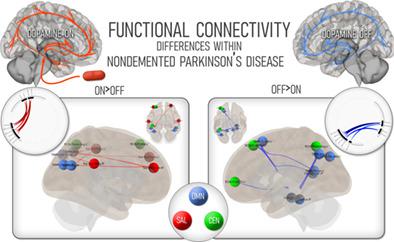当前位置:
X-MOL 学术
›
Hum. Brain Mapp.
›
论文详情
Our official English website, www.x-mol.net, welcomes your feedback! (Note: you will need to create a separate account there.)
The impact of dopaminergic treatment over cognitive networks in Parkinson's disease: Stemming the tide?
Human Brain Mapping ( IF 4.8 ) Pub Date : 2021-09-12 , DOI: 10.1002/hbm.25650 Ignacio Aracil-Bolaños 1, 2, 3, 4 , Frederic Sampedro 1, 2, 3, 4 , Jesus Pujol 5, 6 , Carles Soriano-Mas 6, 7, 8 , José María Gónzalez-de-Echávarri 9 , Jaime Kulisevsky 1, 2, 3, 4 , Javier Pagonabarraga 1, 2, 3, 4
Human Brain Mapping ( IF 4.8 ) Pub Date : 2021-09-12 , DOI: 10.1002/hbm.25650 Ignacio Aracil-Bolaños 1, 2, 3, 4 , Frederic Sampedro 1, 2, 3, 4 , Jesus Pujol 5, 6 , Carles Soriano-Mas 6, 7, 8 , José María Gónzalez-de-Echávarri 9 , Jaime Kulisevsky 1, 2, 3, 4 , Javier Pagonabarraga 1, 2, 3, 4
Affiliation

|
Dopamine-replacing therapies are an effective treatment for the motor aspects of Parkinson's disease. However, its precise effect over the cognitive resting-state networks is not clear; whether dopaminergic treatment normalizes their functional connectivity-as in other networks- and the links with cognitive decline are presently unknown. We recruited 35 nondemented PD patients and 16 age-matched controls. Clinical and neuropsychological assessments were performed at baseline, and conversion to dementia was assessed in a 10 year follow-up. Structural and functional brain imaging were acquired in both the ON and practical OFF conditions. We assessed functional connectivity in both medication states compared to healthy controls, connectivity differences within participants related to the ON/OFF condition, and baseline connectivity of PD participants that converted to dementia compared to those who did not convert. PD participants showed and increased frontoparietal connectivity compared to controls: a pattern of higher connectivity between salience (SN) and default-mode (DMN) networks both in the ON and OFF states. Within PD patients, this higher SN-DMN connectivity characterized the participants in the ON state, while within-DMN connectivity prevailed in the OFF state. Interestingly, participants who converted to dementia also showed higher SN-DMN connectivity in their baseline ON scans compared to nonconverters. To conclude, PD patients showed higher frontoparietal connectivity in cognitive networks compared to healthy controls, irrespective of medication status, but dopaminergic treatment specifically promoted SN-DM hyperconnectivity.
中文翻译:

多巴胺能治疗对帕金森病认知网络的影响:阻止潮流?
多巴胺替代疗法是治疗帕金森病运动方面的有效方法。然而,它对认知静息状态网络的确切影响尚不清楚。多巴胺能治疗是否使它们的功能连接正常化 - 就像在其他网络中一样 - 以及与认知衰退的联系目前尚不清楚。我们招募了 35 名非痴呆 PD 患者和 16 名年龄匹配的对照。在基线时进行临床和神经心理学评估,并在 10 年的随访中评估转化为痴呆。在 ON 和实际 OFF 条件下获得结构和功能脑成像。与健康对照组相比,我们评估了两种药物状态下的功能连通性,参与者内部与开/关条件相关的连通性差异,与未转化的 PD 参与者相比,转化为痴呆的 PD 参与者的基线连通性和基线连通性。与对照组相比,PD 参与者表现出并增加了额顶连接:在 ON 和 OFF 状态下,显着性 (SN) 和默认模式 (DMN) 网络之间的连接性更高。在 PD 患者中,这种更高的 SN-DMN 连接性是参与者处于 ON 状态的特征,而 DMN 内的连接性在 OFF 状态下占主导地位。有趣的是,与未转变者相比,转变为痴呆症的参与者在基线 ON 扫描中也表现出更高的 SN-DMN 连接性。总而言之,与健康对照组相比,PD 患者在认知网络中表现出更高的额顶连接,无论药物状态如何,但多巴胺能治疗特别促进了 SN-DM 超连接。
更新日期:2021-11-01
中文翻译:

多巴胺能治疗对帕金森病认知网络的影响:阻止潮流?
多巴胺替代疗法是治疗帕金森病运动方面的有效方法。然而,它对认知静息状态网络的确切影响尚不清楚。多巴胺能治疗是否使它们的功能连接正常化 - 就像在其他网络中一样 - 以及与认知衰退的联系目前尚不清楚。我们招募了 35 名非痴呆 PD 患者和 16 名年龄匹配的对照。在基线时进行临床和神经心理学评估,并在 10 年的随访中评估转化为痴呆。在 ON 和实际 OFF 条件下获得结构和功能脑成像。与健康对照组相比,我们评估了两种药物状态下的功能连通性,参与者内部与开/关条件相关的连通性差异,与未转化的 PD 参与者相比,转化为痴呆的 PD 参与者的基线连通性和基线连通性。与对照组相比,PD 参与者表现出并增加了额顶连接:在 ON 和 OFF 状态下,显着性 (SN) 和默认模式 (DMN) 网络之间的连接性更高。在 PD 患者中,这种更高的 SN-DMN 连接性是参与者处于 ON 状态的特征,而 DMN 内的连接性在 OFF 状态下占主导地位。有趣的是,与未转变者相比,转变为痴呆症的参与者在基线 ON 扫描中也表现出更高的 SN-DMN 连接性。总而言之,与健康对照组相比,PD 患者在认知网络中表现出更高的额顶连接,无论药物状态如何,但多巴胺能治疗特别促进了 SN-DM 超连接。



























 京公网安备 11010802027423号
京公网安备 11010802027423号